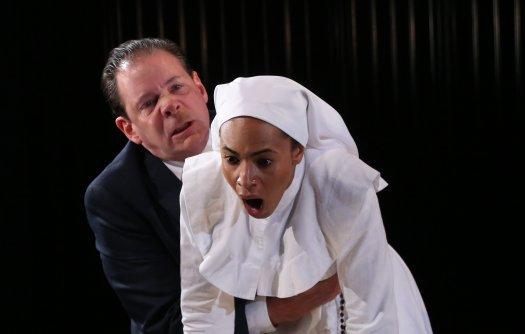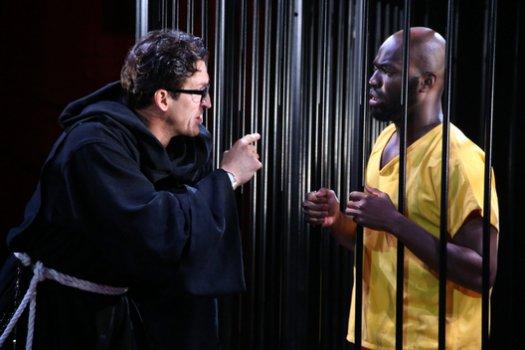Measure for Measure (Theatre for a New Audience)
Simon Godwin, Britain’s go-to director for reimagined classics, stages an updated revival of the problem comedy which offers its contemporary relevance.

Thomas Jay Ryan and Cara Ricketts in a scene from “Measure for Measure” (Photo credit: Gerry Goodstein)
[avatar user=”Victor Gluck” size=”96″ align=”left” ] Victor Gluck, Editor-in-Chief[/avatar]Simon Godwin, an associate director of Britain’s National Theatre, has become the go-to guy for reimagined versions of Shakespeare and modern plays. His London productions of Hamlet set in West Africa and Twelfth Night with Malvolio played by a woman have been both critically acclaimed and controversial. With Measure for Measure, he has now staged his first work by the Bard in New York at Theatre for a New Audience.
He has updated the play to a contemporary city rife with decadence and corruption. The audience enters the theater from backstage in order to visit Mistress Overdone’s brothel with sex toys and rooms for peep shows on display. Twelve members of the audience sit on either side of the thrust stage, a jury for morality one would suspect. The second act begins in a night club called “The Moated Grange” where Mariana is now a singer with the on-stage band. Six audience members are invited up to sit at the café tables that now dot the stage.
While all of this is novel, it does not add anything to the understanding or the enjoyment of a play which has been classified as one of Shakespeare’s “problem comedies.” What it does do is put the play’s relevance to our current state of America in sharp focus in a way it has not been revealed in recent years. Abuse of power, sexual harassment gone unpunished, respected figures having secret sex lives, women’s word not taken against men in sexual harassment claims, a conservative agenda run amok, punitive laws, statutes that do not take into consideration human failings and purveyors of fake news are all parts of Shakespeare’s Renaissance tale and from that point of view it has become a play for our time.

Jonathan Cake and Leland Fowler in a scene from “Measure for Measure” (Photo credit: Gerry Goodstein)
Duke Vincentio, ruler of Vienna, announces that he is immediately departing from the city for a period of time, and puts his rigid, strict deputy Angelo in his place, giving him full power to enforce the laws, even over life and death. In actuality, Vincentio plans to disguise himself as a friar and witness how things turn out in the city with Angelo in charge. Power goes to Angelo’s head and he immediately puts into effect his conservative agenda, closing down all of the brothels and sentencing to death those who are guilty of fornication.
Claudio, brother to the novice nun Isabella, is arrested and sentenced to death in three days, even though it is his own affianced Juliet who has become pregnant while they wait for her dowry to be negotiated. Isabella gains an audience with Angelo to plead for her brother’s life. The celibate Angelo, engaged five years ago to Mariana but broken off when her dowry went down in a shipwreck, is immediately smitten with the comely Isabella and offers her a choice: her virginity for Claudio’s life. Behind the scenes, Vincentio, now Friar Lodowick, follows the events and interferes in some things, allows others to play out. The story of the play is the fall of the seemingly righteous man Angelo and the reeducation of the once laissez-faire Duke.
One of the reasons Measure for Measure has been called a problem comedy, aside from the death sentences hanging over several characters, is why the duke acts the way he does and why he allows things to deteriorate as far as they do. The only modern touch that Godwin has added that is of any consequence goes far to explain all of this. In a prologue not in Shakespeare, the play now begins with a raucous party in which the Duke shoots up heroin and wakes up to find himself on the floor long after it is over. Godwin’s explanation which works well to solving one of the play’s problems is that Vincentio has been a party boy and has not enforced the rules during his 14 year reign.

Zachary Fine and Christopher Michael McFarland in a scene from “Measure for Measure” (Photo credit: Gerry Goodstein)
Except for British actor Jonathan Cake’s complex but pedantic Vincentio, the characterizations are mainly one dimensional. Canadian actress Cara Ricketts making her New York debut is an impassioned Isabella but is not moving or poignant, a problem actresses often have playing a role which uses intellectual arguments to make an emotional appeal. As the rigid Angelo, Thomas Jay Ryan’s overly mannered performance does not suggest that he gets any enjoyment out of the power he now wields. Leland Fowler’s Claudio seems very superficial, but this may be a choice to explain the character’s low ethics. Angelo’s second-in-command, Escalus, has been turned into the female role of Escala. While January Le Voy is quite convincing as an efficient sidekick, she does not bring any special qualities to the role undermining the possibilities.
The production is more successful with its comic characters. Haynes Thigpen has a field day as Lucio, the young nobleman and friend to Claudio who isn’t above twisting the truth at all times to serve his purposes. Christopher Michael McFarland is delightfully pompous as the pimp and pub keeper to Mistress Overdone’s once prosperous brothel in better times. (He would make a terrific Falstaff.) Zachary Fine is amusing as the simple-minded Constable Elbow. Kenneth De Abrew, one of many actors doubling and tripling, is notable as both the tipsy gentleman Froth and the authoritarian executioner Abhorson.
On the serious side, Oberon K.A. Adjepong is a very solid Provost, warden of the prison where so much of the action takes place. As often in Shakespeare, the other women’s roles are minor giving Merritt Janson’s castoff fiancée Mariana, Sam Morales’ Claudio’s beloved Juliet, and LaVoy’s Mistress Overdone little to do. The minimal sets by Paul Wills allow for quick transitions between scenes but offer only a stark sort of atmosphere. His costumes are more successful but only for the comic characters. Matthew Richards’ lighting plot has some film noirish effects. While Godwin’s Measure for Measure is tricked out with a great many unsuccessful contemporary touches, it is left to Shakespeare’s story to bring home the dangers of abuse of power and hewing to the letter of the law rather than the spirit.
Measure for Measure (through July 16, 2017)
Theatre for a New Audience
Samuel H. Scripps Mainstage, Polonsky Shakespeare Center, 262 Ashland Place, in Brooklyn
For tickets, call 866-811-4111 or visit http://www.tfana.org
Running time: two hours and 50 minutes with one intermission






Leave a comment